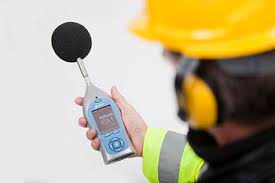Occupational Noise Survey
Eastern Safety Services provides measurement of noise levels in the workplace based on current CSA standard for testing. To maintain a safe workplace, it’s essential to regularly identify and evaluate noise levels and types that may be harmful to the hearing of your workers. Eastern Safety Services can conduct noise measurement tests to determine the extent of any noises that may be damaging. We can also advise on what to do if these measurements indicate excessive noise and provide a range of solutions to minimise the risk of hearing damage occurring.
Workplace Noise Surveys
A noise survey report, otherwise known as a noise assessment, is conducted to measure and report on noise levels at various locations. This involves testing specific work functions and operator levels within the workplace, providing an excellent and concise way of establishing sound energy levels. This method of noise measurement allows for the calculation of exposure time limits**, which vary by province, for employees, as well as determining the adequacy of current hearing protection in use. If exposure limits are exceeded, occupational health and safety regulations and standards may not be met, making testing essential to maintain compliance.
** Noise Exposure Standard in Newfoundland and Labrador: 85dBA noise level for 8 hours and peak noise level 140dBC. For every 3dB above this, the duration of exposure is halved, e.g. If the noise level is 88dBA, the maximum duration a worker may work is 4 hours. The appropriate attenuation rating of a hearing protector will result in keeping the exposure below the standard.
Personal Noise Exposure Calculations
An individual’s personal noise exposure for an entire shift can be calculated using a dosimeter (also known as a dosebadge). A dosimeter is an electronic sound recording device that can be fitted to an employee for the duration of their shift, giving an accurate noise assessment that can determine if harmful levels of noise are present. It can effectively measure and record sound energy levels experienced throughout an entire work shift. This type of noise measurement device is generally used for employees that have more than one job function, including workers who move about the premises frequently or who are exposed to intermittent noise sources. For example, an individual that works in a metal workshop using hammers may not be exposed to a constant noise, so should wear a dosimeter that will provide an accurate noise assessment measuring across the entire shift.
We experience noise regularly at work. We don’t always measure it, but when we do, we do so for a reason. We want to test whether or not the noise we hear meets or exceeds certain criteria. When you measure noise for the purpose of testing whether something meets or exceeds certain criteria, keep in mind the following tips.
5 Tips for Noise Measurements & Testing
- Know your location. Note the background noise (called ambient noise), as well as the weather conditions (temperature, humidity, and wind speed).
- Know your object. For industrial noise control, it is crucial to know the operating conditions of the equipment being tested. If noise measurements in testing do not correspond to the machine noise in the field, then the measurements do not actually tell you whether equipment will meet or exceed criteria. That’s a problem.
- Know your equipment. Make sure you have a recently calibrated sound level meter with a good microphone. Only up to date calibration records demonstrate accurate calibration.
- Know the criteria. Be clear about the requirements. For example, do the noise measurements test for the maximum noise level, the average, or an equivalent level? How many measurement locations are specified by the criteria? Where should the measurements be made (the operator’s ear, or the property line, etc.)?
Keep records of the above, including date and time, as well as a short narrative of the event.
The above may seem overly cumbersome, but it can prevent future difficulties. And if it all seems too complicated; Eastern Safety Services can help. We have been completing occupational measurement testing for compliance for many years including the offshore, municipalities and workplaces.
Why measure noise in the workplace?
Measuring noise levels and workers’ noise exposures is the most important part of a workplace hearing conservation and noise control program. It helps identify work locations where there are noise problems, employees who may be affected, and where additional noise measurements need to be made.
For more information on measuring and assessing noise levels in the workplace, please call us at 709-757-7111.

